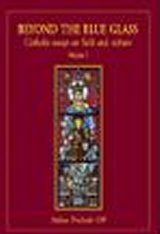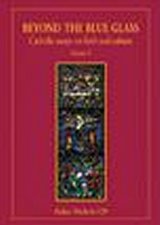|

Beyond the Blue Glass, Volume I
Catholic Essays on Faith and Culture
Aidan Nichols OP
ISBN 1 901157 16 4, 210 pages, clothbound, £14.95 ($26.95 in USA).
The first of two volumes of dazzling essays on faith and culture by one of the most
gifted and erudite Catholic thinkers today. The range and depth of these essays is remarkable, covering many of
the most significant themes and theologians of the twentieth century: liturgy, literature, the Anglican "Radical
Orthodoxy" movement, Scheeben, Newman and, of course, St Thomas. What is particularly impressive about this
collection is the way in which Nichols presents us with a panoramic sweep in which clarity, detail and sobriety
are not sacrificed to scope and virtuosity. No one interested in the major issues of modern theology will want
to miss this book.
Essays include:
- St Thomas in His Time
- Thomism and the Nouvelle Théologie
- Balthasar and Rahner: "Anonymous Christianity"
in Question
- Cardinal Ratzinger on Theology, Liturgy and Faith
- A Tale of Two Documents: Sacrosanctum Concilium and Mediator Dei
- Liturgy as Consummate Philosophy: A Reading of Pickstock's
After Writing
"Father Aidan Nichols is the most prolific and versatile English Catholic
theologian of his generation. He deserves a high place of honour in that Dominican
Gallery of which he is himself the historian." Professor John Saward
Jeremy de Satgé, The Catholic Herald, 17 May, 2002
"This is an impressive volume of essays…The depth of the author’s knowledge is remarkable."
AD2000
book review
link
About the Author
Fr Aidan Nichols, O.P., is the Prior of Blackfriars, Cambridge, and author of some twenty-five books, including
Dominican Gallery, The Shape of Catholic Theology, The Theology of Joseph Ratzinger: An Introductory Study and
the forthcoming Discovering Aquinas.
Excerpted from Beyond the Blue Glass Vol I by
Aidan Nichols. Copyright © 2002. Reprinted by permission. All rights reserved.
ST THOMAS IN HIS TIME
St Thomas was born in 1225 into a pro-imperial Italian aristocratic family, the
de Aquinos, who had land and a castle at Roccasecca, half way between Rome and Naples, just to the east of that
great thoroughfare, the Via Latina. His parents – Lombard on his father's side, Neapolitan on his mother's – sent
him to the boarding school run by the monks of Monte Cassino and arranged for him to become an oblate there, planning
so to make use of their local influence as to have him, in due course, elected to the abbatial dignity. For Cassino
was, to the feudal nobility of the region, a great prize. When he was fifteen, however, and could have made solemn
profession (the oblateship was understood in this period in a way which makes it comparable to simple profession
in the modern Latin church), the abbot of Monte Cassino advised his parents to send him, rather, to the emperor
Frederick II's studium generale at Naples – probably because skirmishes between emperor and pope were making Cassino
too hot for comfort. He would have lived, no doubt, in the Neapolitan study house owned by the Cassinese monks,
the dedication of which, a significant pointer to the half-Greek character of southern Italy in the Middle Ages,
was to St Demetrios of Thessalonica.
Naples was a cosmopolitan place, as were generally southern Italy and Sicily under
the influence of a ruler who sat lightly to his own religion (and anyone else's). There Thomas was introduced by
one Michael the Irishman to the latest ideas in the shape of the natural philosophy of Aristotle.
Arab astronomy and Greek medicine would also have been capital in this University milieu. Catching a whiff of pagan
naturalism at Naples was important: in Paris at the same period the study of Aristotle was officially forbidden.
At the age of nineteen Thomas joined the newly instituted Order of Friars Preachers – a priory had been founded
at Naples in 1231 by Jordan of Saxony, St Dominic's successor. He did so in the teeth of opposition from his family,
who resorted to such low tricks as abduction and (attempted) seduction: abducting Thomas while he was on his way,
in the entourage of the Master of the Order, John the Teuton, to the 1244 General Chapter in Bologna, and attempting
to seduce him by introducing a prostitute from the camp following of their military retinue into his room at Roccasecca,
during his "house arrest". The claim that the reason for their opposition was social embarrassment, much
as if a son of the Duke of Buccleuch had absconded from Eton to become a hippy in Islington, though widely made
by socially radical Thomists in the 1960s, looks less plausible when we learn that the friar who gave him the habit,
his namesake Thomas de Lentini, shortly after became bishop of Bethlehem, papal legate and patriarch of Jerusalem.
Benedictine influence would in any case linger in the form of Thomas's habitual citation of Gregory the Great (nearly
two thousand five hundred times), and especially of the latter's Dialogues, on the life and miracles of St Benedict,
which Thomas drew on heavily in his theological defence of the Religious life. Thomas's last known writing is a
letter of 1274 to abbot Bernard Ayglier of Monte Cassino where, as his most recent biographer, Père Jean-Pierre
Torrell, writes, he "refound spontaneously his language as a young monk and presented himself as ‘a son always
ready for prompt obedience'".
In all probability, St Thomas passed over to the Dominicans chiefly because he saw there greater opportunities
for the study and communication of the fruits of contemplation to others for which he had already developed the
aptitude at Cassino – though we cannot rule out as a possible secondary factor in his renunciation of life in that
well-endowed monastery a desire for evangelical simplicity. Père Chenu called his departure from Cassino
"the exact replica of the gesture of Francis of Assisi", inasmuch as St Francis repudiated his father's
wealth, St Thomas the great riches of his abbey. In his treatise in support of the friars, Thomas will call Religious
poverty an outstanding lesson of the Cross of Christ.

Beyond the Blue Glass, Volume II
Catholic Essays on Faith and Culture
Aidan Nichols OP
ISBN 1 901157 17 2, 250 pages, clothbound, £14.95 ($26.95 in USA).
More essays on Catholic faith and culture from the England's acclaimed Dominican
theologian. Includes: Orthodox: Soloviev and the Papacy; Muslims: a Beginners' Guide to Militant Islam; Syncretists:
the Gospel and the 'New Age'; Monks: the Spiritual Doctrine of Columba Marmion; Friars: the Utility of Augustine's
Rule for Preachers; Millenial Perspectives, from Incarnation to Parousia.
Preface
Part One: THEOLOGY
1 St Thomas in his Time
2 Thomism and the Nouvelle Théologie
3 A View from Cologne: the Fate of Patristic Trinitarianism in Modern Catholic Theology
4 Littlemore from Lucerne: Cardinal Newman seen by Cardinal Balthasar
5 Balthasar's Aims in his Theological Aesthetics
6 Rahner and Balthasar: "Anonymous Christianity" in Question
7 Cardinal Ratzinger on Theology, Liturgy, Faith
Part Two: LITURGY
8 Odo Casel Re-visited
9 A Tale of Two Documents: Sacrosanctum Concilium and Mediator Dei
10 Hymns Ancient and Postmodern: Liturgy as Consummate Philosophy
If you wish to purchase either of these two books, go to website of
The Saint Austin Press
Version 4th July 2009
|

